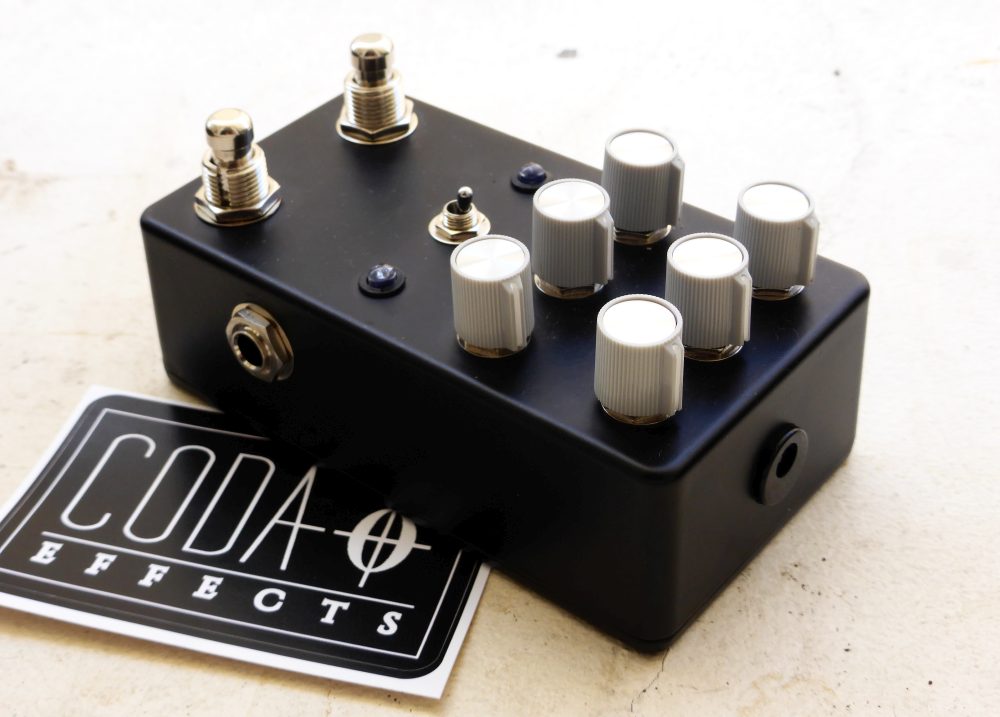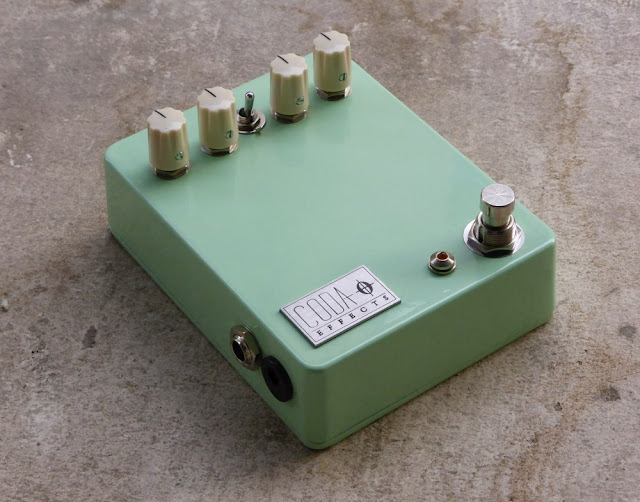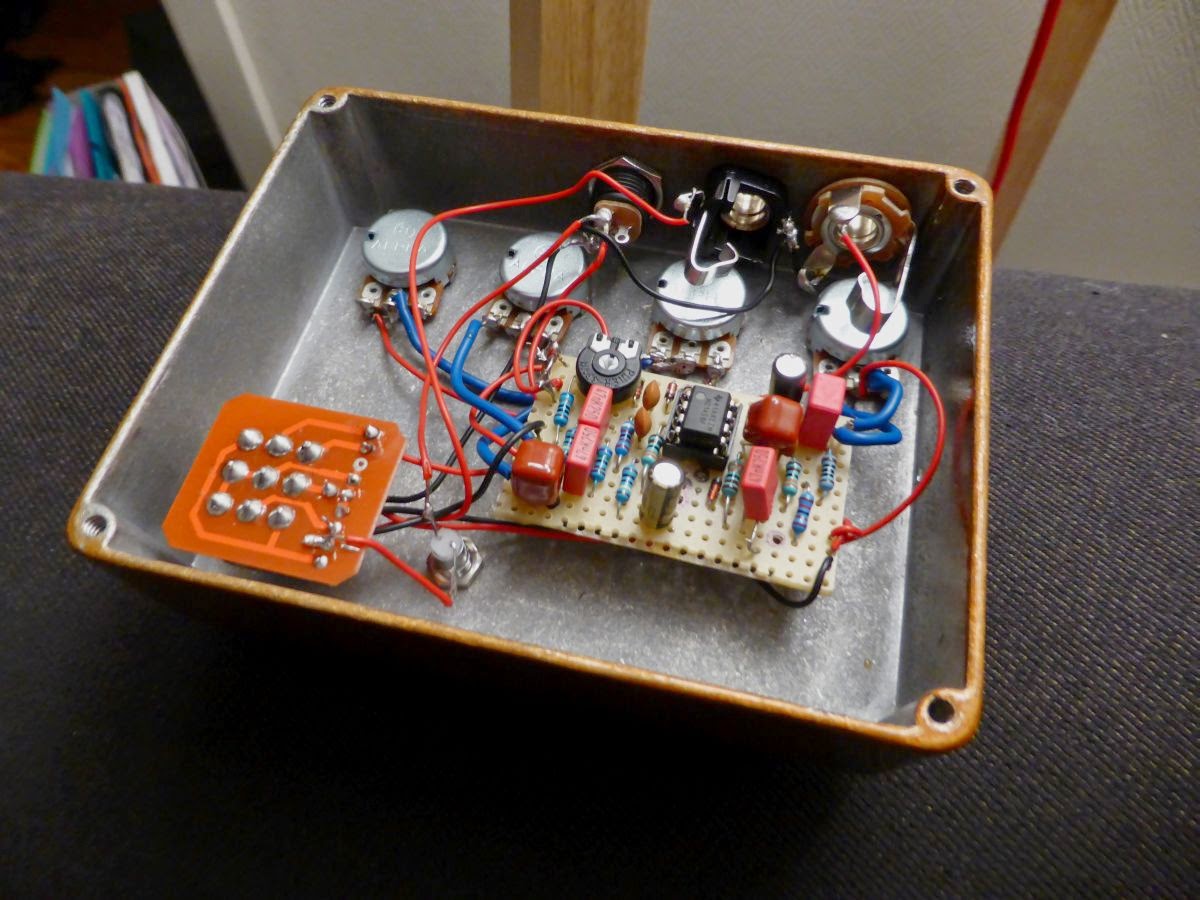Hi guys!
Here is my latest big project. It is a 3 Fuzz-in-one-box pedal, with a switchable upper octave. This is my first prototype, I will make another one with some changes, but I wanted to share this one with you.
There are 3 fuzz circuits inside this pedal :
- A silicon Fuzz Face. I wanted to make it germanium, but the NPN germanium that I have found (russian MP38A) are waaaay to big for the available space in this tight, tight (and messy) build. So silicon it is! Cleans well with guitar volume, nice on saturated amp, cool fuzz!
- A Muff Fuzz. I used the circuit with a feedback loop. However, it sound really similar to the Fuzz Face, so I plan on replacing it by a OP amp version of the muff fuzz.
- Companion Fuzz / Sin Ei FY2 I have never built it before, it is a nice spitty, gritty velcro fuzz! I guess that it can sound very cool on bass, on guitar, it gives a nice "brass" feeling, a bit like the old Maestro fuzz. Low output volume though
A rotary switch allows you to choose between no fuzz, Fuzz Face, Muff Fuzz or Companion Fuzz;

Then, there is a Klon buffer to diminish the impedance, and a low pass filter to remove some trebles.
Finally, a LPB1 restore a full volume and can also boost the signal.
Before the fuzz, tone and volume section, there is a Green Ringer that is switchable (on-off), to add a nice upper octave. Depending on the selected fuzz, it can make a classic jimi sound, or a crazy noisy stuff (with the companion fuzz )
)
I replaced the 10k resistor of the emitter of the first transistor to adjust the octave (there is kind of a sweet spot, but other settings with less octave are interesting too).
I am not sure that it is better that the Green Ringer is before fuzz though... I heard that it sounded quite good after the fuzz....
I designed the PCB, made mistakes, and several modifications to it, so it is quite a mess inside! Well, prototypes are for that!


As mentioned before, I plan on modifying it a bit:
- replace the LPB1 by a classic OP amp boost using the second OP amp of the TL072 used for buffering the signal before the tone section. I will gain some space, some output volume, and it will be more transparent.
- Replace the muff fuzz by the OP amp version of the muff fuzz. The Muff Fuzz with the feedback loop is really close to the Fuzz Face so it is not really interesting.
- I looking on increasing the output of the companion fuzz. I guess the volume drop is due to the scooped mids tonestack. I have read topic with people recommending to place a trimpot below the capacitor going to ground... Have you ever tried that ?
Finally, what do you think about the green ringer before the fuzz ? Should I place it after ? Or is there another octave circuit that can be easier to use ? (but also works on a clean sound)
Thank you !
Benoit
Here is my latest big project. It is a 3 Fuzz-in-one-box pedal, with a switchable upper octave. This is my first prototype, I will make another one with some changes, but I wanted to share this one with you.
There are 3 fuzz circuits inside this pedal :
- A silicon Fuzz Face. I wanted to make it germanium, but the NPN germanium that I have found (russian MP38A) are waaaay to big for the available space in this tight, tight (and messy) build. So silicon it is! Cleans well with guitar volume, nice on saturated amp, cool fuzz!
- A Muff Fuzz. I used the circuit with a feedback loop. However, it sound really similar to the Fuzz Face, so I plan on replacing it by a OP amp version of the muff fuzz.
- Companion Fuzz / Sin Ei FY2 I have never built it before, it is a nice spitty, gritty velcro fuzz! I guess that it can sound very cool on bass, on guitar, it gives a nice "brass" feeling, a bit like the old Maestro fuzz. Low output volume though
A rotary switch allows you to choose between no fuzz, Fuzz Face, Muff Fuzz or Companion Fuzz;

Then, there is a Klon buffer to diminish the impedance, and a low pass filter to remove some trebles.
Finally, a LPB1 restore a full volume and can also boost the signal.
Before the fuzz, tone and volume section, there is a Green Ringer that is switchable (on-off), to add a nice upper octave. Depending on the selected fuzz, it can make a classic jimi sound, or a crazy noisy stuff (with the companion fuzz
 )
)I replaced the 10k resistor of the emitter of the first transistor to adjust the octave (there is kind of a sweet spot, but other settings with less octave are interesting too).
I am not sure that it is better that the Green Ringer is before fuzz though... I heard that it sounded quite good after the fuzz....
I designed the PCB, made mistakes, and several modifications to it, so it is quite a mess inside! Well, prototypes are for that!


As mentioned before, I plan on modifying it a bit:
- replace the LPB1 by a classic OP amp boost using the second OP amp of the TL072 used for buffering the signal before the tone section. I will gain some space, some output volume, and it will be more transparent.
- Replace the muff fuzz by the OP amp version of the muff fuzz. The Muff Fuzz with the feedback loop is really close to the Fuzz Face so it is not really interesting.
- I looking on increasing the output of the companion fuzz. I guess the volume drop is due to the scooped mids tonestack. I have read topic with people recommending to place a trimpot below the capacitor going to ground... Have you ever tried that ?
Finally, what do you think about the green ringer before the fuzz ? Should I place it after ? Or is there another octave circuit that can be easier to use ? (but also works on a clean sound)
Thank you !
Benoit

 This is my second prototype. It uses my relay bypass switching scheme. It uses the TAPLFO from Electric Druid, and is quite close from the circuit presented in the datasheet.
This is my second prototype. It uses my relay bypass switching scheme. It uses the TAPLFO from Electric Druid, and is quite close from the circuit presented in the datasheet.








mo+iQ~~/s-l1600.jpg)









